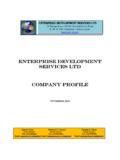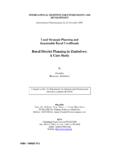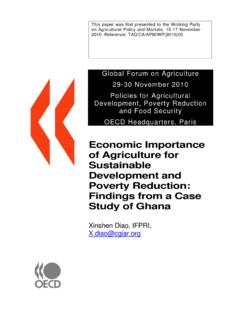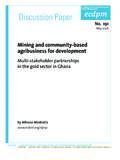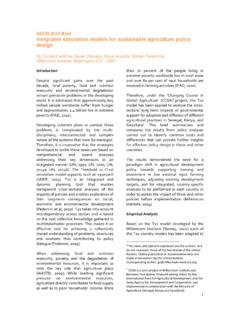Transcription of On-farm feeding and feed management in …
1 I3481E/1 978-92-5-107978-2 ISSN 2070-7010978 9251 079782 FAOOn- farm feeding and feed management in aquacultureThis technical paper provides a comprehensive review of On-farm feeding and feed management practices in aquaculture . It comprises of a) ten case studies on feeding and feed management practices carried out in seven selected countries of Asia and Africa for eight species that belong to four major farmed species of freshwater finfish and shellfish; b) an analysis of the findings of the above ten case studies and a separately published case study for Indian major carps carried out in India;c) ten invited specialist reviews on feed management practices from regional and global perspectives.
2 And d) an overview of the current status of feed management broad thematic areas that were addressed in these case studies and invited reviews arei) current feed types (including fertilizers) and their use in semi-intensive and intensive farming systems; ii) On-farm feed production and management ; iii) feeding and feed management strategies, feed procurement, transportation and storage; iv) environmental, economic, regulatory and legal frameworks of feeding and feed management practices; and iv) identification of research on the information presented in the eleven case studies, ten specialist reviews and from other relevant publications, an overview paper presents concluding remarks and recommendations on some of the major issues and constraints in optimizing feed production, use and feeding and feed management in aquaculture583 FAOFISHERIES ANDAQUACULTURETECHNICALPAPER583 ISSN 2070-7010 Cover photographs:Left top to bottom: feeding grow-out striped catfish (Pangasianodon hypophthalmus) with farm -made aquafeed from a feeding station,Mekong delta, Viet Nam (courtesy of Nguyen).
3 A farmer feeding black tiger shrimp (Penaeus monodon) with commerciallyproduced pelleted feed from levee during first month of rearing (courtesy of FAO/Umesh N. Ramasawamy).Right: feed distribution using automatic feeder for cage culture of Atlantic salmon (Salmo salar) near Bodo in Norway(courtesy of Trevor Telfer).Cover design:Mohammad R. 220/01/2014 11:12:46 FAOFISHERIES ANDAQUACULTURETECHNICALPAPER583On- farm feedingand feed managementin aquacultureEdited by Mohammad R. HasanAquaculture OfficerAquaculture BranchFAO Fisheries and aquaculture DepartmentRome, ItalyandMichael B. NewFAO ConsultantMarlow, BucksUnited Kingdom of Great Britain and Northern IrelandFOOD AND AGRICULTURE ORGANIZATION OF THE UNITED NATIONS Rome, 2013 The designations employed and the presentation of material in thisinformation product do not imply the expression of any opinion whatsoeveron the part of the Food and Agriculture Organization of the United Nations(FAO) concerning the legal or development status of any country, territory, cityor area or of its authorities, or concerning the delimitation of its frontiers orboundaries.
4 The mention of specific companies or products of manufacturers,whether or not these have been patented, does not imply that these havebeen endorsed or recommended by FAO in preference to others of a similarnature that are not views expressed in this information product are those of the author(s) anddo not necessarily reflect the views or policies of 978-92-5-107978-2 (print)E-ISBN 978-92-5-107979-9 (PDF) FAO, 2013 FAO encourages the use, reproduction and dissemination of material in thisinformation product. Except where otherwise indicated, material may becopied, downloaded and printed for private study, research and teachingpurposes, or for use in non-commercial products or services, provided thatappropriate acknowledgement of FAO as the source and copyright holder isgiven and that FAO s endorsement of users views, products or services is notimplied in any requests for translation and adaptation rights, and for resale and othercommercial use rights should be made via addressed to information products are available on the FAO website ( )
5 And can be purchased through of this documentThis technical paper was prepared by a group of experts under the leadership ofDr Mohammad R. Hasan as a part of the Food and Agriculture Organization of the United Nations (FAO) aquaculture Service s (FIRA) ongoing regular work programme on Studies, reviews, guidelines and manuals on use of feed and nutrient in sustainable aquaculture development , under the organizational output aquaculture practices and technologies that comply with the Code of Conduct for Responsible Fisheries (CCRF) are developed and promoted .This technical paper reviews the current status of On-farm feeding and feed management in aquaculture .
6 It contains a) ten case studies on feeding and feed management practices carried out in seven selected countries of Asia ( , Bangladesh, China, India, Thailand, Viet Nam) and Africa ( , Egypt, Ghana) for eight species belonging to four major farmed species of freshwater finfish and shellfish: shrimp and prawns, Nile tilapia, striped catfish and Indian major carps; b) an analysis of the findings of these ten case studies and a case study for Indian major carps in India (published separately1); c) ten invited specialist reviews on feed management practices from regional and global perspectives and d) an overview of the current status of feed management practices with information drawn from the case studies, the invited reviews and other related publications.
7 In addition, a targeted workshop entitled On-farm feeding and feed management in aquaculture was convened in Manila, the Philippines, from 13 15 September 2010 where all the above case study reports, analysis of case studies and invited review papers were presented. The workshop was organized by the Fisheries and aquaculture Department aquaculture Service (FIRA) and was hosted by the Southeast Asian Fisheries Development Center aquaculture Department (SEAFDEC/AQD), Iloilo, the Philippines. The report of the workshop was published as a FAO Fisheries Report ( ).Before editorial work, the manuscripts in this technical paper were reviewed for technical content, FAO house style and linguistic quality by Dr Richard Arthur for the invited reviews and synthesis paper and by Dr Thomas Shipton for the case studies.
8 For consistency and conformity, scientific and English common names of fish species were used from FishBase ( ). Much gratitude is due to the authors of the invited reviews and case studies, who faced an enormous task and showed tremendous patience with the editors. Ms Tina Farmer and Ms Marianne Guyonnet are acknowledged for their assistance in quality control and FAO house style. Mr Koen Ivens prepared the layout design for printing, and Ms Danielle Rizcallah provided miscellaneous assistance. The publishing and distribution of the document were undertaken by FAO, Rome. Finally, Jiansan Jia, Chief of the aquaculture Branch of the FAO Fisheries and aquaculture Department is acknowledged for providing the necessary support, advice and insight to initiate the study and to complete the publication is organized in three sections: a) Overview and Synthesis,b) Case Studies, and c) Invited Reviews.
9 The publication is printed with the first section overview and synthesis while the whole volume is available on a CD ROM accompanying the printed part of this Ramakrishna, R., Shipton, T. & Hasan, 2013. feeding and feed management of Indian major carps in Andhra Pradesh, India. FAO Fisheries and aquaculture Technical Paper No. 578. Rome, FAO. 90 technical paper provides a comprehensive review of On-farm feeding and feed management practices in aquaculture . It comprises of a) ten case studies on feeding and feed management practices carried out in seven selected countries of Asia and Africa for eight species that belong to four major farmed species of freshwater finfish and shellfish; b) an analysis of the findings of the above ten case studies and a separately published case study for Indian major carps carried out in India; c) ten invited specialist reviews on feed management practices from regional and global perspectives; and d) an overview of the current status of feed management practices.
10 The country-specific case studies were carried out for Nile tilapia (Oreochromis niloticus) in China, Thailand, the Philippines, Egypt and Ghana; Indian major carps [rohu (Labeo rohita), catla (Catla catla) and mrigal (Cirrhinus cirrhosus)] in India and Bangladesh, giant river prawns (Macrobrachium rosenbergii) in Bangladesh, striped catfish (Pangasianodon hypophthalmus) and whiteleg shrimp (Litopenaeus vannamei) in Viet Nam and black tiger shrimp (Penaeus monodon) in India. The broad thematic areas that were addressed in these case studies and invited reviews are: i) current feed types (including fertilizers) and their use in semi-intensive and intensive farming systems; ii) On-farm feed production and management ; iii) feeding and feed management strategies, feed procurement, transportation and storage; iv) environmental, economic, regulatory and legal frameworks of feeding and feed management practices; and iv) identification of research needs.











